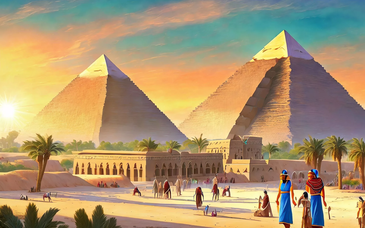The following is a list of various important rulers and events that occurred during their reign. All dates are BC, unless otherwise stated.
Predynastic Period (c.5000-31000 BC)
c.3400: The kingdom of the Red Land is established in the north, White Land in the south; they are ruled concurrently under two kings.
c.3200: Scorpion, a southern king, makes preliminary attempts to conquer the northern kingdom.
c.3100: Menes (Narmer) subdues the north and unifies the two lands.
Archaic Period (c.3100-2786 BC)
Dynasty 1 (c.3100-2890)
c.3100-?: Menes founds the unified kingdom of Egypt with capital at White Walls (Memphis). Beginning of the historical period.
c.2985-2930: Den pursues an active foreign policy, sending an expedition to Nubia. Innovations are introduced in design of royal burial monuments at Abydos. Double Crown appears, symbolizing unity of the two predynastic kingdoms.
Dynasty 2 (c.2890-2686)
c.2700: King Peribsen and supporters of the god Seth lose struggle with supporters of the cult of Horus; Horus becomes royal patron deity.
Old Kingdom (c.2686-c.2181 BC)
Dynasty 3 (c.2686-2613)
c.2667-2648: King Djoser requests royal architect Imhotep to design world's first major stone building -- the Step Pyramid at Saqqara.
c.2637-2613: Under Huni, construction is possibly started on the transitional Meidum pyramid.
Dynasty 4 (c.2613-2494)
c.2613-2589: Sneferu. Two pyramids are built at Dashur, including the Bent Pyramid; the Meidum pyramid is also possibly built.
c.2589-2566: Cheops. Great Pyramid at Giza is built; it is the largest pyramid ever constructed.
c.2558-2553: Chephren. Second pyramid as well as the Great Sphinx are built at Giza.
c.2528-2500: Mycerinus. Third pyramid at Giza is constructed.
c.2500-2496: Shepseskaf. In break with pyramid-building tradition, the mastaba tomb is revived with the building of the Mastabat Fara'un.
Dynasty 5 (c.2494-2345)
c.2494-2487: Userkaf. The sun cult is promoted. A sun temple is built at Abu Ghorub as well as a smal pyramid at Saqqara.
c.2487-2473: Shaure. The royal cemetary at Abusir inaugurated; Sahure and his successors build pyramids here, including one with particularly fine wall reliefs.
c.2473-2463: Neferirkare (Kakai). A pyramid is built at Abusir.
c.2463-2422: Niuserre. Builds sun temple at Abu Ghurob as well as pyramid at Abusir.
c.2375-2345: Unas. Pyramids are once again built at Saqqara; Unas's pyramid complex has the best preserved causeway and contains the earliest examples of Pyramid Texts.
Dynasty 6 (c.2345-2181)
c.2345-2333: Teti. Builds his pyramid at Saqqara.
c.2322-2282: Pepy I. Also builds his pyramid at Saqqara.
2269-c.2175: Pepy II. The longest reign, but royl power declines and the kingdom disintegrates. Builds his pyramid at Saqqara.
First Intermediate Period (c.2181-1991 BC)
Dynasty 7 (c.2181-2173)
The Old Kingdom collapses, and a period of social upheaval and political chaos follows. Rapid succession of Memphis-based rulers.
Dynasty 8 (c.2173-2160)
Succession of Memphis-based rulers continues.
Dynasty 9 (c.2160-2130)
c.2160: At Heracleopolis, the local ruler Achthoes I seizes power and rules over parts of Egypt. He is succeeded by a line of seventeen kings ruling from Heracleopolis in Dynasties 9 and 10.
Dynasty 10 (c.2130-2040)
Dynasty 11 (c.2133-1991)
2060-2010: Mentuhotep (Nebhepetre), a local Theban prince, reunites Egypt and builds a unique and spectacular funerary monument at Deir el-Bahri, Thebes.
2009-1998: Mentuhotep (S'ankhkare).
1997-1991: Mentuhotep (nebtowyre). The last ruler of Dynasty 11, he is assasinated. His vizier, Amenemhet, userps the throne and founds the Middle Kingdom, ruling as Amenemhet I.
Middle Kingdom (1991-1786 BC)
Dynasty 12 (1991-1786)
1991-1962: Amenemhet I. Reorganizes Egypt and moves capital north to It-towy. he is buried nearby in a pyramid in the new cemetary at el-Lisht.
1971-1928: Senurset I. Coregent with Amenemhet I, he extends Egyptian power and furthers Egypt's interests abroad.
1929-1895: Amenemhet II. Continues pursuing contacts with Syria/Palestine. Builds his pyramid at Dashur.
1897-1878: Senusret II. Undertakes a major land reclamation and builds works in the Fayoum, an oasis area. Constructs his pyramid at Lahun.
1878-1843: Senusret III. During a successful reign he completes the process of colonizing Nubia, where he builds or extends a series of fortresses. Abolishes powers and priveledges of nobles (by unknown means), thus removing a great threat to royal power.
1842-1797: Amenemhet III. the Middle Kingdom reaches the pinnacle of its prosperity. Projects are built in the Fayoum, and quarrying expeditions are sent to Sinai.
1798-1790: Amenemhet IV. The kingdom begins to decline. He is ousted by his sister, Sobekneferu.
1789-1786: Sobekneferu. The queen regnant. Dynasty 12 comes to an end.
Second Intermediate Period (1786-1567 BC)
Dynasty 13 (1786-1633)
Line of sixty kings continues to rule from Thebes.
Dynasty 14 (1786-c.1603)
Simultaneous line of seventy-six kings rules from Xois in the Dlta; this line had seceded and established itw own dynasty of kings at the end of Dynasty 12.
Dynasty 15 (1674-1567)
The Hyksos invade Egypt and form two dynasties (15 and 16) of foreign kings.
c.1570: Hyksos ruler Auserre Apophis I encounters opposition from native Theban princes of Dynasty 17.
Dynasty 16 (c.1684-1567)
Dynasty 17 (c.1650-1567)
c.1575: Theban ruler Seqenenre Ta'o II fights bravely against the Hyksos (Auserre Apophis I); possibly dies in battle.
New Kingdom (1567-1085 BC)
Dynasty 18 (1567-1320)
1570-1546: Amosis I. The founder of the dynasty expels the Hyksos from Egypt and pursues them to Palestine.
1546-1526: Amenhotep I. Lays the foundations for the Egyptian Empire with his conquests in Syria/Palestine. He builds a rock-cut tomb, rather than a pyramid, at Dra'abu el-Naga, Thebes, and founds a community of royal necropolis workmen.
1525-1512: Tuthmosis I. A grat warrior, he leads campaigns in Nubia and Syria. His tomb is the first in the Valley of the Kings at Thebes.
c1512-1504: Thuthmosis II. Marries Hatshepsut.
1503-1482: Hatshepsut. After seizing the throne from her stepson, Tuthmosis III, she bcomes queen regnant. She buiolds a fine temple at Deir el-Bahri, Thebes.
1504-1450: Tuthmosis III. Upon reaching adulthood, he regains power from Hatshepsut to become Egypt's greatest military leader. He extends the empire in Syria, crossing the Euphrates River and defeating Egypt's greatest enemy, the Mitannians. Embarks on major building program at Temple of Amun at Karnak and elsewhere.
1450-1425: Amenhotep II. The son of Tuthmosis III is a great warrior and sportsman. His tomb in Valley of the Kings is used during Dynasty 21 to rebury a cache of royal mummies.
1425-1417: Tuthmosis IV. Creates peace alliance with mitanni and marries a Mitannian princess. Aten starts to become a seperate and important deity.
1417-1379: Amenhotep III. A great builder, he also promotes the cult of Aten. Tiye, his wife, is a powerful queen despite her nonroyal origins. Egypt's power and wealth are at their zenith; diplomacy replaces warfare.
1379-1362: Amenhotep IV (Akhenaten). A religious revolutionary, he disbands the traditional priesthoods and introduces an exclusive, near-monotheistic worship of the Aten. The court and capital are moved to Akhetaten (Tell el-Amarna), where he and his queen, Nefertiti, pursue the cult. Akhenaten produces no male heirs.
c.1364-1361: Smenkhkare. Son-in-law of, possibly half-brother of, and perhaps coregent with Akhenaten.
1361-1352: Tutankhamun. Another son-in-law of Akhenaten, he begins the gradual restoration of the traditional religion and returns the religious capital to Thebes. He dies young, leaving no heirs; his tomb and treasure are discovered in the Valley of the Kings in AD 1922.
1352-1348: Ay. An elderly courtier, he inherits the throne and continues the restoration of religious traditions.
1348-1320: Horemheb. Of obscure, non-royal parentage, he was previously the army command er under Akhenaten. In his Edict, Hotemheb takes firm measures to restore the traditional religion as well as law and order. He obliterates traces of Atenism, and Akhetaten is finally deserted.
Dynasty 19 (1320-1200)
1318-1304: Sethos I. A warrior king, he reestablishes the empire in Syria/Palestin, which had been allowed to slip away during Akenaten's reign. Along with Ramesses II, he undertakes major building programs, including temples at Thebes and Abydos. His tomb is the largest in the Valley of the Kings.
1304-1237: Ramesses II. A noted warrior and prolific builder, he is possibly the pharaoh of the Old Testament's Exodus. Egypt wars against Hittites before eventually making a peace treaty with them.
1236-1223: Merenptah. Son of Ramesses II, he defeats the threat posed by a coalition of Libyans and Sea Peoples.
Dynasty 20 (1200-1085)
1198-1166: Ramesses III. The last great warrior king defeats the Libyans (years 5 and 11) and Sea Peoples (year 8). He builds a magnificent temple at Medinet Habu, Thebes, and his tomb in the Valley of the Kings. The royal necropolis workforce conducts strikes. The so-called Harem Conspiracy fails to assassinate the king.
1160-1156: Ramesses V. The Turin Papyrus and the Wilbour Papyrus are written.
1140-1121: Ramesses IX. Tomb robberies occur, while royal workman strikes continue.
1113-1085: Ramesses XI. The kingdom is virtually divided in half: the king rules the north, but the high priests of Amun seize power and attain near-equal status, effectively ruling the south from Thebes. Ramesses XI's royal burial is the last in the Valley of the Kings.



